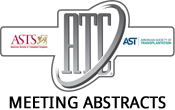2017 American Transplant Congress
Glomerular CD45 Immunostaining in Post Perfusion Graft Biopsies Predicting Rejection.
Renal Transplant Unit, University Hospitals Coventry, Coventry, United Kingdom
Introduction: Recipients of incompatible renal allografts remain at risk of developing AMR after transplantation. Current microarray analysis of allograft biopsies showed similar disturbances in AMR…2017 American Transplant Congress
Determinants of Severe Interstitial Fibrosis in Kidney Allografts: Major Impact of Circulating Donor-Specific Anti-HLA Antibodies.
Paris Translational Research Center for Organ Transplantation, Paris, France
Interstitial fibrosis represents a major cause of kidney allograft failure. We investigated the independent contribution of circulating donor-specific anti-HLA antibodies (DSA) in the development of…2017 American Transplant Congress
Early Antibody-Mediated Rejection C4d Status Remains a Marker of Prognosis in HLA-Incompatible Kidney Transplantation.
1CHP, Porto, Portugal; 2IPST, Porto, Portugal
Banff criteria for the diagnosis of antibody-mediated rejection (AMR) in kidney transplantation (KT) was recently updated to include the entity of C4d negative AMR, if…2017 American Transplant Congress
DSA Presence Does Not Affect Renal Histology and Clinical Outcome in Chronic Active Antibody Mediated Rejection.
1Erasmus MC, Rotterdam, Netherlands; 2Leiden UMC, Leiden, Netherlands
Introduction. Chronic active antibody mediated rejection (caABMR) is a major cause of long term renal allograft dysfunction. It is defined by the presence of microvascular…2017 American Transplant Congress
Identification of NKG2D as Senescence Marker in Zero-Hour Kidney Biopsies Is Indicative for Clinical Outcome.
The definition of biological donor organ age rather than chronological age seems an obvious factor for the establishment of valid pre-transplant risk assessment. We therefore…2017 American Transplant Congress
Role of Chemokines in Resolution of BK Virus-Associated Nephropathy and Chronicity of Pathology Changes in Kidney Transplant Recipients.
David Geffen School of Medicine at UCLA, Los Angeles, CA
BK virus-associated nephropathy (BKN) remains the most common infectious cause of allograft loss after kidney transplantation. We previously demonstrated increased frequency of polyfunctional T cells…2017 American Transplant Congress
Improvement in Inflammatory Response Follows Clearance of BKVN.
Intro: Development of BKV nephropathy (BKVN) is a significant risk factor for graft loss. Proximate cause of graft loss is commonly attributed to acute/chronic rejection…2016 American Transplant Congress
Digital Kidney Biopsy Evaluation: Quantification of Macrophage Prevalence in a Cross Sectional Study.
Standardized markers based on quantitative and qualitative evaluation of immune cell mass and localization in kidney biopsies may help in diagnosis and prognosis in transplantation…2016 American Transplant Congress
The Impact of Microvascular Inflammation (MVI) in Kidney Transplant Biopsies (KTxBx) Is Independent of Time Post-Transplant.
Detection of MVI in a KTxBx, often associated with antibody mediated rejection, is associated with a poor prognosis for kidney graft survival. However most information…2016 American Transplant Congress
Decellularized Rat Liver Scaffolds Support Multilineage Xenogenic and Heterogenic Cell Growth.
University of Maryland School of Medicine, Baltimore, MD.
Background:Recent years have seen a proliferation of methods leading to successful organ decellularization. Nonetheless, the ability to reproducibly generate a robust recellularized construct remains challenging.…
- « Previous Page
- 1
- …
- 6
- 7
- 8
- 9
- 10
- …
- 12
- Next Page »
